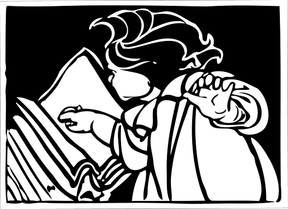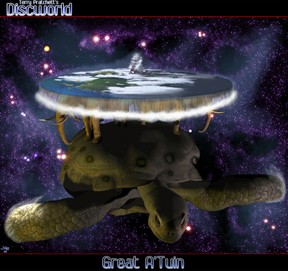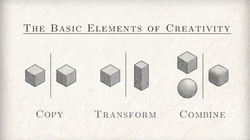 I'm a great believer in enjoying a good book, then rewinding at the end to discover how the author did that.
I'm a great believer in enjoying a good book, then rewinding at the end to discover how the author did that.
For our purposes right now, we are looking at the moment when you simply could not put a novel down.
This isn't that situation when you're stuck on a long 'plane flight, or lounging on a beach and can't be bothered to actually move. This is when your entire life has to go on hold - and you will not be disturbed (barring actual life and death scenarios) - because you HAVE to know what happens next.
Those authors definitely knew how to get you onto the next page and, indeed, all the way to the end without stopping.
It's happened to me twice this year. Nick Sagan's Idlewild series achieved it for about the sixth time running (and I even know exactly how that one ends). Connie Willis's Blackout wiped out a whole day. It then had me scrambling to order the sequel in from America, at a higher price, because it hadn't even been released in my country yet.
They patently got it right.
Glancing through, I notice the usual tricks - cliffhanger chapter endings, great first lines in the next one. But there is something else too. Both authors add pseudo-chapters in between each part.
Nick Sagan's writing style follows a formula. First we get a transcript from a transmission. It's short. It's all in capitals (thus looks urgent). It reveals an important clue for the rest of the story. Then we get a flashback. It's again short. It's in italics, which underscores the fact that it's going to be short. It provides a context for the rest of the story.
Only then do we get to the actual chapter. That sequence continues, in the same order, every time a chapter ends.
You might as well read the transmission. It'll take whole seconds and it's going to provide food for thought. Then you might as well read the flashback for all of the same reasons. (All of this with the paused action from the last proper chapter lodged in your head.) But both of those things are going to give you something eye-opening to contemplate.
How will this affect the characters?! You read on to find out, because those two pseudo-chapters have already delivered you into the next proper chapter anyway. It's an endless cycle, which takes you all of the way to the final page.
Connie Willis does something slightly less elaborate, but still enticing. All of her chapters, in both Blackout and the sequel All Clear, begin with a quotation. Each one is very short. It's perhaps a single line. It might even be a solitary word. But it sets the scene for the whole chapter to come.
Here's an example from page 301 of All Clear, after the previous chapter ended with everyone going to St Paul's:
That won't be there in the morning.
- FIREMAN, ON SEEING ST PAUL'S SURROUNDED BY FIRES, 29 December 1940.
So you finish the previous chapter on a cliffhanger. You might as well read the quotation, as it's both there and short. Oh my! That's going to happen to the characters?! And you read on.



 "I'll just read to the end of this chapter and then I'll *insert action*." How often have you said this yourself?
"I'll just read to the end of this chapter and then I'll *insert action*." How often have you said this yourself?

 The absolute number one tip for enticing readers onto the next chapter is to leave the previous one on a cliffhanger.
The absolute number one tip for enticing readers onto the next chapter is to leave the previous one on a cliffhanger.


 I'm a great believer in enjoying a good book, then rewinding at the end to discover how the author did that.
I'm a great believer in enjoying a good book, then rewinding at the end to discover how the author did that.


 I love Terry Pratchett. I can (and have) read his DiscWorld series over and over again. They never get old. I never tire of them.
I love Terry Pratchett. I can (and have) read his DiscWorld series over and over again. They never get old. I never tire of them.







 St Tydecho's Churches in West Waleson 09/03/2014
St Tydecho's Churches in West Waleson 09/03/2014
 Goodies for an Outlander Premiere Partyon 03/06/2015
Goodies for an Outlander Premiere Partyon 03/06/2015
 Holocaust Memorial Day Interview with Rainer Höss, Grandson of Rudolf Architect of Auschwitzon 01/24/2015
Holocaust Memorial Day Interview with Rainer Höss, Grandson of Rudolf Architect of Auschwitzon 01/24/2015
 Romantic Valentine Gifts for an Outlander Fanon 01/16/2015
Romantic Valentine Gifts for an Outlander Fanon 01/16/2015



Comments
:D So big question - who was the best Dr Who ever?
Yes! Being raised on old Doctor Who, I am utterly unable to compose without cliffhangers at the end of every chapter. Unfortunately, they also taught me cliches and melodrama, which I'm still trying to eradicate.
The best way to learn how to write is to read. If you have read something wonderful, then you go back to work out how it was done.
Thank you for the compliment. <3
I'm a reader and not a writer, but I certainly enjoy reading your insights! I agree that you have great info here, and on your other well-written pages that can be of use to other writers.
I'm glad that you liked it; and hope that you enjoy the others too.
Great advice Jo. I'm off to read your other articles about creative writing.
Very good luck with it. And please drop back and let us know when it's available to read. We'll be able to say that we knew the writer before you were famous!
Thanks for the tips, I'm currently writing an ebook for the kindle so this is very useful!
Win! \o/
You will be the first, promised - if I ever finish it ;-) SY